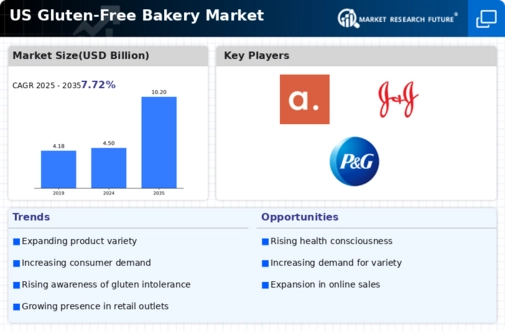Expansion of Retail Channels
The gluten free-bakery market is experiencing an expansion of retail channels, which enhances product accessibility for consumers. Supermarkets, health food stores, and online platforms are increasingly stocking gluten-free products, making it easier for consumers to find and purchase these items. The rise of e-commerce has particularly transformed the shopping experience, allowing consumers to explore a wider range of gluten-free options from the comfort of their homes. This trend is supported by data indicating that online grocery sales in the US have surged, with gluten-free products being a significant category. As retail channels continue to diversify, the gluten free-bakery market is poised for growth, reaching a broader audience and meeting the needs of various consumer segments.
Shifts in Dietary Preferences
The gluten free-bakery market is influenced by shifts in dietary preferences, as more consumers adopt specialized diets. The rise of plant-based and clean eating trends has led to an increased interest in gluten-free options, as these diets often align with gluten-free principles. Many consumers perceive gluten-free products as healthier alternatives, even if they do not have gluten sensitivities. This perception is supported by market data indicating that the gluten free-bakery market is expected to reach a valuation of $5 billion by 2026. As dietary preferences continue to evolve, the gluten free-bakery market is likely to expand, with manufacturers innovating to create products that cater to these changing consumer needs.
Growing Awareness of Food Allergies
The gluten-free bakery market is significantly impacted by the growing awareness of food allergies and intolerances. As more individuals become educated about food sensitivities, the demand for gluten-free products has surged. This awareness is not limited to celiac disease; many consumers are increasingly recognizing gluten as a potential allergen, leading to a broader market for gluten-free baked goods. Educational campaigns and advocacy from health organizations have played a crucial role in informing the public about gluten-related disorders. Consequently, the gluten free-bakery market is likely to see continued growth as consumers seek safe and delicious alternatives to traditional baked goods.
Rising Demand for Gluten-Free Products
The gluten-free bakery market experiences a notable increase in demand as consumers become more health-conscious. This trend is driven by a growing awareness of gluten-related disorders, such as celiac disease and gluten sensitivity. According to recent data, approximately 1 in 100 individuals in the US are affected by celiac disease, leading to a heightened need for gluten-free alternatives. Additionally, many consumers without gluten sensitivities are opting for gluten-free products, believing them to be healthier. This shift in consumer behavior is propelling the gluten free-bakery market forward, as manufacturers strive to meet the needs of a diverse customer base. The market is projected to grow at a CAGR of around 9% over the next few years, indicating a robust future for gluten-free offerings.
Increased Availability of Gluten-Free Ingredients
The gluten free-bakery market benefits from the enhanced availability of gluten-free ingredients, which facilitates product development and innovation. As more suppliers enter the market, the variety of gluten-free flours, starches, and binders has expanded significantly. This influx of ingredients allows bakers to create a wider range of gluten-free products, from breads to pastries, that meet consumer expectations for taste and texture. Furthermore, the US government has implemented regulations that support the labeling of gluten-free products, ensuring that consumers can easily identify safe options. This regulatory framework, combined with the growing ingredient supply, is likely to bolster the gluten free-bakery market, making it easier for businesses to cater to the increasing demand for gluten-free baked goods.














Leave a Comment